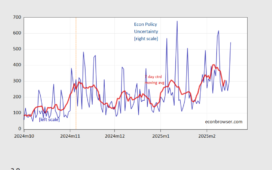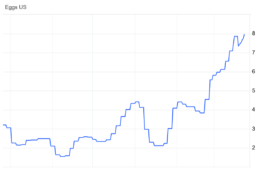By Dan Falk, a science journalist based in Toronto. His books include “The Science of Shakespeare” and “In Search of Time.” Orignally puhlished at Undark.
It’s not clear who first said that “writing about music is like dancing about architecture,” but they had a point: Music exerts a certain power over us, but it’s not the sort of power one can readily quantify or analyze. Music moves us, often very deeply — but how? If anyone is qualified to tackle this age-old question, it’s Daniel J. Levitin, an award-winning neuroscientist, musician, and author who has spent a lifetime immersed in the world of music, both as a scientist and as a musician and producer. (Levitin’s bestselling 2006 book, “This Is Your Brain on Music: The Science of a Human Obsession,” is a sweeping exploration into the connections between music and the brain.)
Levitin, a professor emeritus at McGill University and a visiting professor at UCLA, is back with a new book called “I Heard There Was a Secret Chord: Music as Medicine” (the first part of the title is a quotation from the Leonard Cohen song “Hallelujah”). His focus is the myriad ways in which music can help to heal our bodies and our minds.
Music, Levitin asserts, helps us cope with trauma. Playing or listening to music, he explains, can tweak the body’s levels of serotonin and dopamine. Music also stimulates the brain’s ability to make new neurons, as well as new connections between them, “enhancing brain recovery, and normalizing the stress response.”
Music can also treat movement disorders. Levitin notes that “the motor and movement pathways in our brain are activated by music, they synchronize to it, and our limbic system” — the part of the brain responsible for emotions — “signals pleasure when they do.”
He lists five particular movement disorders for which patients have been shown to respond to music therapy: stuttering, Tourette syndrome, Huntington’s disease, multiple sclerosis, and Parkinson’s disease. And even with other conditions, such as ALS (amyotrophic lateral sclerosis, or Lou Gehrig’s disease), where Levitin says more research is needed, music has still been found to relieve anxiety and depression, and to improve quality of life.
That music can be used to treat depression will probably not come as a surprise: Even those who have never sought out medical treatment for depression will have witnessed the power of music to lift one’s mood. Levitin notes how music helped record producer Quincy Jones deal with depression: “Music made me full, strong, popular, self-reliant and cool,” he quotes from Jones’ autobiography. In a similar vein, Bruce Springsteen has described music as a form of medicine, one that has brought him a kind of peace “that’s very, very, very difficult to come by,” he told the PBS NewsHour.
Music can have a positive effect for other ailments, too. Alzheimer’s disease is, without doubt, one of the cruellest of afflictions. Levitin’s description of guitarist Glen Campbell’s battle with the disease is heartbreaking. After receiving his diagnosis, Campbell continued to tour. “He did not know what city he was in,” Levitin writes, “and often couldn’t remember that he had just played a song, and so would play it twice or even three times in a row.” Yet in spite of these challenges, Campbell’s performances were still rock solid.
While there is no cure for Alzheimer’s, Levitin shows that music can, at least temporarily, loosen the disease’s grip. He describes the case of a man named George who was diagnosed with the disease at age 72. Six years later he could no longer walk or communicate, other than the ability to deliver a “yes” or a “no.” But the care home where he resided often had music playing, and, as George’s neurologist told Levitin, it made a difference. George “could sing when the music played as if he were 30 years old again.”
Even if music does not slow or stop the progress of Alzheimer’s or other forms of dementia, it can improve a patient’s quality of life by relieving anxiety and agitation. Levitin cites the work of Frank Russo and Adiel Mallik at Toronto Metropolitan University. The pair has been modeling the brain’s “relaxation network” and developing therapies to help manage certain symptoms of dementia. Levitin says their research is “pointing an arrow toward musical medicine for relaxation” and highlights the value of non-pharmacological treatments.
One limitation with the kinds of treatments that Russo and Mallik have been investigating is that it’s hard to scale them up, since there are far fewer therapists than people in need of therapy. Here, Levitin suggests that artificial intelligence can help. AI can assist “in selecting music that meets both an individual’s tastes and desired therapeutic and wellness goals. Several start-up companies are doing just that.” This line of research, he says, “can usher in a new age of personalized music medicine.”
Levitin’s personal relationships with some of the artists gives the book a warmth it might otherwise lack. He is a long-time friend of singer-songwriter Joni Mitchell, who was hospitalized after suffering a brain aneurysm in 2015. Once Mitchell was back at home, Levitin arranged for Mitchell’s nurses to play a CD that she had put together years earlier as part of Starbucks’ “Artist’s Choice” series — a customized set of songs, performed by some of Mitchell’s favorite artists.
Levitin told the nurses to start off playing the disc once a day, and to ask Mitchell when to play it and how often to do so. After playing the CD for Mitchell the first time, the verdict was in: “The nurses called me later that afternoon and said it was the first time they’d seen her smile since coming home.” Mitchell’s condition gradually improved. Levitin believes music was likely just one factor in her recovery, but suggests that it was, at the very least, a catalyst.
While Levitin makes a strong case that music can heal, he also points to some unavoidable truths about the conditions that many musicians suffer from, seemingly out of proportion to the population at large. Professional musicians, Levitin writes, are more likely to be addicted to drugs and alcohol, and are more likely to die violent deaths (or to die from an overdose, or from liver disease) than non-musicians. Levitin cites a British study that found 71 percent of musicians had panic attacks or high levels of anxiety, while 69 percent suffered from depression (a rate three times higher than among the general public).
The underlying reasons behind these disparities are not fully understood, and many intersecting factors may be at work. Levitin suggests that one factor may be the high stakes associated with success or failure in the music business. “Their failures tend to be very public,” he writes. “More so than in many occupations, a performer’s sense of self and self-worth becomes tied to their identity and status as a musician.”
Nonetheless, the reader is left with the conviction that the pros of listening to or playing music far outweigh the cons. Levitin points to research that says music can relieve pain and strengthen our immune system; that it can lift our energy levels when we exercise; that it can make us more empathetic. Learning a musical instrument can improve attentional focus, enhance verbal ability, and improve brain health.
The book covers more than just music’s power to heal. Levitin explores a diverse array of adjacent topics — the complex connections between music and memory, for example, or how people with Williams syndrome (a genetic disorder marked by delayed development and mild intellectual disability, among other distinct characteristics) or autism spectrum disorder respond to, or make, music.
And while the book is anchored by science, Levitin recognizes science’s limitations. Toward the end, he muses philosophical as he returns to the enigmatic question of how music affects us so profoundly. In the end, music is an ambiguous art form, and this ambiguity is part of its magic.
Understanding how music moves us involves science, but also asks us to embrace something beyond science. This engrossing, compassionate, and thoroughly researched book reveals just how much we’ve learned about the interplay between the world of sound and the world inside our heads, even as it leaves the magic behind the music intact.














